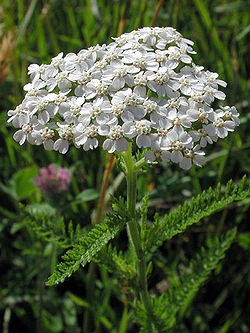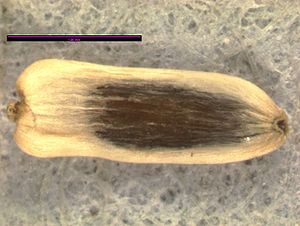Difference between revisions of "Achillea millefolium"
(→Photo Gallery) |
(→Photo Gallery) |
||
| Line 68: | Line 68: | ||
'''Longitudinal Cross Section:''' obovate [[File:ACMI-long-crosssection.png]] | '''Longitudinal Cross Section:''' obovate [[File:ACMI-long-crosssection.png]] | ||
==Photo Gallery== | ==Photo Gallery== | ||
| − | <gallery | + | <gallery> |
| − | + | Image:Achillea millefolium.jpg | |
| − | + | Image:Achillea millefolium single.jpg | |
</gallery> | </gallery> | ||
Revision as of 11:43, 30 April 2012
Achillea millefolium, or common yarrow, is a herbaceous flowering plant in the Asteracae family. Sometimes also called western yarrow, millefoil, bloodwort, carpenter's weed, plumajillo, and hierba de las cortaduras.
Synonyms:
- Achillea borealis
- Achillea lanulosa Nutt. var. eradiata
- Achillea lanulosa Nutt. var. lanulosa
- Achillea millefolium L. ssp. lanulosa
- Achillea millefolium L. var. alpicola
- Achillea millefolium L. var. borealis
- Achillea millefolium L. var. californica
- Achillea millefolium L. var. lanulosa
- Achillea millefolium L. var. litoralis
- Achillea millefolium L. var. millefolium
- Achillea millefolium L. var. occidentalis
- Achillea millefolium L. var. pacifica [1]
Contents
Taxonomy
- Kingdom Plantae – Plants
- Subkingdom Tracheobionta – Vascular plants
- Superdivision Spermatophyta – Seed plants
- Division Magnoliophyta – Flowering plants
- Class Magnoliopsida – Dicotyledons
- Subclass - Asteridae
- Order - Asterales
- Family Asteraceae – Aster family
- Genus Achillea L. – yarrow
- Species Achillea millefolium L. – common yarrow
Description
Herbaceous perennial growing from rhizomes, from one to several stems up to heights of 8 to 16 inches. Tripinnate and lance-shaped leaves evenly distributed along stem with the leaves becoming smaller towards the top. Leaves typically between 1/4 inch to 1 1/4 inch wide and 1 1/4 inch long to 6 inches long. Flat-topped flower heads (inflorescence) containing 10-20 whitish to yellowish flowers. [2]
Bloom Period
April-October [3]
Distribution
"Widespread throughout North America" [2]
Habitat
Common in open dry to moist areas from high to low elevations; drought tolerant [3]
Uses
Several tribes of the Plains region of the United States including the Pawnee and Chippewa tribes used common yarrow. The Pawnee used the stalk in a treatment for pain relief. The Chippewa used the leaves in a steam inhalant for headaches. They also chewed the roots and applied the saliva to their appendages as a stimulant. The Cherokee drank a tea of common yarrow to reduce fever and aid in restful sleep. [2]
Propagation
Clean seeds with hammer mill then air screen cleaner. Sow in field between May or June and September. Plant 50-70 seeds per foot 1/2" deep or less spaced in 3" rows.
Seed
Abbreviation: ACMI
Seed sample from: 2011
Average Measurement: 1.9 x 0.6 x 0.3
Measurement Range: L: 1.6 - 2.1, W: 0.5 - 1, D: 0.2 - 0.5
Features
Shape: Seed narrowly winged at margins, thicker in the middle. Seed face is narrower at hilum end, broadening at opposite side.
Color: Seed coat papery and white, becoming transparent at the center to reveal a red-brown inner seed.
Surface: Finely longitudinally ridged.
Latitudinal Cross Section: elliptical ![]()
Longitudinal Cross Section: obovate ![]()
Photo Gallery
References
- ↑ Washington Flora Checklist
- ↑ 2.0 2.1 2.2 USDA Plants Profile for Achillea Millefolium
- ↑ 3.0 3.1 WTU Image Collection:Plants of Washington
Basic Explanations and Assumptions:
The dimensions for the seeds are length x width x depth. The location of the hilum is used as the base of the seed, and the length is measured from hilum to the opposite apex. Where a style is present, the length is measured from the hilum to the bottom of the style. Width is measured at a right angle to the length at the widest part. Depth is measured at a right angle to the intersection of height and width lines.
Measurements included are the mean average for each measurement of ten separate seeds.
All measurements in millimeters unless otherwise noted.




